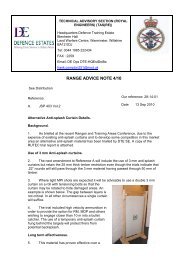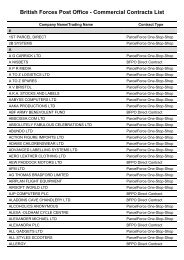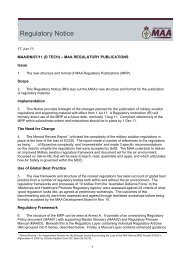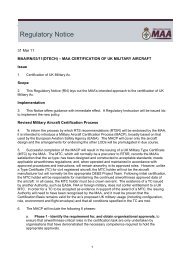Policy Paper No 4. Defence Acquisition PDF - Ministry of Defence
Policy Paper No 4. Defence Acquisition PDF - Ministry of Defence
Policy Paper No 4. Defence Acquisition PDF - Ministry of Defence
You also want an ePaper? Increase the reach of your titles
YUMPU automatically turns print PDFs into web optimized ePapers that Google loves.
The specific objectives <strong>of</strong> Smart <strong>Acquisition</strong> are:<br />
◆ Delivering projects which meet or better the time, cost and performance targets<br />
which were set when the decision to proceed with the project was made.<br />
◆ Acquiring capability progressively, at lower risk, and with the right balance<br />
between military effectiveness, time and whole-life costs.<br />
◆ Cutting the time for key technologies to be introduced into the front-line, where<br />
needed to secure military and industrial advantage.<br />
Central to Smart <strong>Acquisition</strong> are Integrated Project Teams (IPT), each formed to acquire and<br />
support a particular capability. Each IPT comprises personnel drawn from key specialisms,<br />
including requirement definition, technical, financial, contracts and logistics experts. IPT<br />
members may be civil servants, Service personnel or from industry. The breadth <strong>of</strong> expertise<br />
and multi-disciplinary nature <strong>of</strong> IPTs underline the commitment to a “whole life” approach,<br />
from procuring and supporting equipment to final disposal. To ensure continuity, the IPT<br />
remains in being throughout the life <strong>of</strong> a project, transferring from the DPA to the DLO (see<br />
below) when the equipment enters service. IPT Leaders are responsible for managing<br />
projects without day-to-day direction from a management hierarchy and, in consultation<br />
with customers, for making performance/time/cost trade-<strong>of</strong>fs within approved parameters.<br />
IPT Leaders are selected on merit by competition, against criteria which include leadership<br />
as well as requisite core and functional skills. The MOD’s experience is that the new system<br />
is working well.<br />
It has long been a criticism <strong>of</strong> the acquisition <strong>of</strong> defence equipment that the process simply<br />
takes too long and is too complex; the equipment is out <strong>of</strong> date or the requirement has<br />
changed by the time it has come into service. A key aspect <strong>of</strong> Smart <strong>Acquisition</strong> has thus<br />
been the MOD’s attempt to streamline the whole acquisition process. Central to this has<br />
been a rationalisation <strong>of</strong> the equipment approvals process. The number <strong>of</strong> points at which a<br />
major equipment programme is approved for continuance has been cut from four to two -<br />
at project initiation (Initial Gate), and prior to the main investment decision (Main Gate).<br />
The Initial Gate is a relatively low hurdle, designed specifically to encourage early and full<br />
exploration <strong>of</strong> a wide range <strong>of</strong> options and trade-<strong>of</strong>fs for meeting a particular capability, and<br />
with emphasis on investment in early risk reduction work. This ensures that the widest<br />
possible set <strong>of</strong> options for meeting a capability requirement is considered. By the time Main<br />
Gate is reached, the IPT Leader must have a high level <strong>of</strong> confidence <strong>of</strong> being able to deliver<br />
the project to narrowly defined performance, cost and time parameters.<br />
Of course, requirements may change during the course <strong>of</strong> a major project, owing to<br />
technological developments or as a result <strong>of</strong> lessons learned from recent experience. The<br />
risks associated with such changes can be reduced through ‘Incremental <strong>Acquisition</strong>’. This<br />
Smart <strong>Acquisition</strong> principle aims to develop systems which can be upgraded in a planned<br />
way, bringing an initial baseline capability into service early and then progressively<br />
incorporating evolving technology as it becomes available.<br />
Two other important guiding principles characterise Smart <strong>Acquisition</strong>. The first is that there<br />
should be more investment during the early stages <strong>of</strong> a project, the aim being to reduce as<br />
5












![MAA Regulatory Publications - FAQs PDF [37.3 KB]](https://img.yumpu.com/5906104/1/184x260/maa-regulatory-publications-faqs-pdf-373-kb.jpg?quality=85)


![3750 edition 6 PDF [263.5 KB] - Ministry of Defence](https://img.yumpu.com/5901071/1/184x260/3750-edition-6-pdf-2635-kb-ministry-of-defence.jpg?quality=85)

